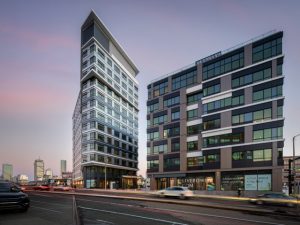TAT showcases urban transformation and innovation with Boston mixed-use complex

Photo courtesy TAT
The Architectural Team (TAT) has completed Bower, a mixed-use infill complex transforming the area around Boston’s historic Fenway Park into a connected, walkable, and vibrant neighborhood with new rental housing and retail offerings, transit access, and public space.
As the first phase of the highly anticipated transit-oriented Fenway Center development, Bower offers 312 residential units and 3716 m2 (40,000 sf) of commercial space across two buildings. Community resources including a 1161-m2 (12,500-sf), multilevel pedestrian plaza offer vital connections between the growing Fenway, Kenmore, and Longwood Medical Area neighborhoods.
Bower is notable for its market-leading focus on resident health and well-being. Certified Leadership in Energy and Environmental Design (LEED) Gold and pursuing a Fitwel certification, the project sets a new standard for residential development in New England with thoughtful amenities, innovative material choices including dynamic glazing that adjusts to ambient light conditions, and biophilic interiors by Planeta Design Group.
“Bower stands among the most significant infill developments Boston has seen in a generation, and it is a valuable example for other cities and sites where tangible quality-of life benefits to residents and the public at large are the crux of improving their urban experience,” said Jay Szymanski, AIA, NCARB, LEED AP, a principal at TAT.
“The design team used an array of natural materials, fluid forms, and reflective elements to enhance the feeling of bringing the outdoors inside,” said Patrick Planeta, Planeta Design Group principal. “This design approach was also informed by evolutionary psychology that offers clues to understanding automatic responses triggered by our modern, man-made surroundings.”
An urban design success story, decades in the making
Working in tandem to define the irregularly shaped site, Bower’s two buildings—one at eight stories and the second at 14—offer a striking and highly visible new presence in Boston. The smaller structure, Tower 1, mirrors its midrise surroundings with a gridded and textured façade whose moody colors and window patterns recall the area’s industrial heritage. Set above an airy retail podium, its taller counterpart, the long and thin Tower 2, presents a dynamic, faceted appearance that seems to shift in form and weight, tapering to sharp points at either end.
Built on what was previously a series of parking lots and underutilized, state- and city-owned land, Bower helps fill a longstanding gap in Boston’s urban network created by highway construction in the 1960s. TAT’s design reknits this fabric through a combination of clever massing of the two Bower structures—which rise in height and scale from historic Beacon Street to the highway—and the creation of the new public plaza whose meandering paths link the buildings and provide, for the first time, a fully accessible pedestrian connection from Beacon Street 7 m (23 ft) down to David Ortiz Drive and Fenway Park below.
According to the architects, realizing the Bower project meant overcoming significant design challenges resulting from the complex mix of infrastructural uses at the site—a set of technical hurdles and solutions ranging from the need to build around a municipal gas line just 457 mm (18 in.) away from the buildings’ foundation walls, to the relocation of a water line, and the use of extensive temporary bracing to support the foundation itself as it was poured. The successful navigation of these challenges reflects the outcome of innovative design solutions and close collaboration and coordination between an array of private entities and public officials and agencies.
Via: https://www.constructionspecifier.com/
